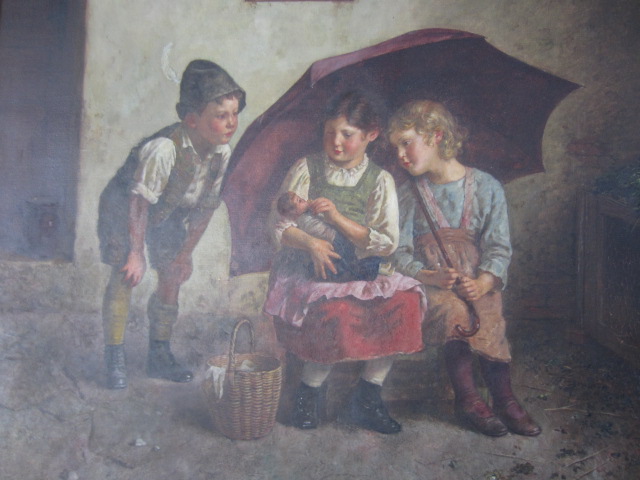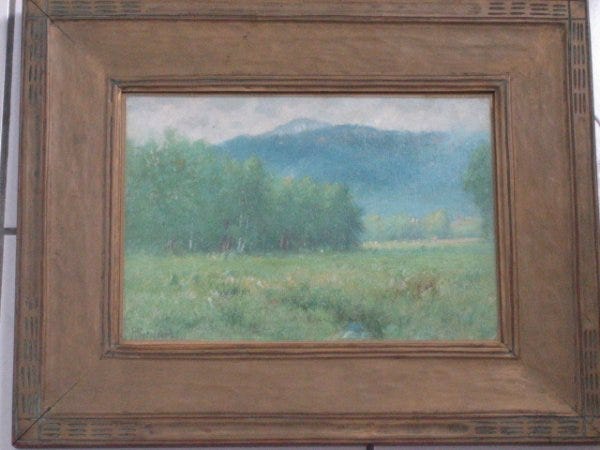We find antique paintings in many of the estates we help liquidate, especially here in New England. Perhaps after we determine who painted it, the first question clients ask is: “Is my painting worth any real money?”
The answer often isn’t simple or easy to determine, and of course the value varies from piece to piece. Still, as both an auctioneer and an appraiser of art, I have some straightforward ways to tell whether your painting will add to your finances or just to your décor:
 Edmund Adler oil on canvas painting
Edmund Adler oil on canvas painting
1. Is it a painting and not a print? Prints often look like paintings to the naked eye. If you check your piece with a magnifying glass, you may find dots, the copyright mark (Ⓒ), or other indications that it is just a print. You may also see a number like “246/500” signed in pencil, along with the artist’s name. These markings are seen on limited edition prints or AP (artist proof) prints. They have some value, but typically are not as valuable as an original painting. There are exceptions, though. Nearly 20 years ago, we sold a group of prints that were signed by Andy Warhol. They brought around $500 then and may be worth even more if auctioned today. If you are confident you have a painting, you can look for other signs to be even more certain. Look at the details of the painting detail. Do the details, like hands in a portrait or items in the background of a scene, look like they are painted well? If you see what looks like the work of human hands, then it is probably a painting and not a print.
2. Does the frame look antique? The frame can give you a rough sense of the age of the painting. If it is in an antique gold-leaf frame, for instance, the painting may date from the 19th century.
3. Is it on canvas, and is the canvas clearly old? Paintings on canvas are typically more valuable than those painted on board. Also, oil paintings typically bring more than watercolors or pastels. If the painting is on canvas, turn it around and check the canvas for the discoloration you might expect of an older painting.
4. Does the provenance date back many decades and seem to have a compelling story? Merriam-Webster defines “provenance” as “the history of ownership of a valued object or work of art or literature.” Provenance is important with paintings, as with other antiques. We sold an abstract painting by a French artist at one of our auctions. The winning bidder asked for the name of the family that owned the estate who consigned it so that he could track the ownership of the painting and prove it was original.
5. Is the artist listed? When you have the artist’s name you can look it up in Davenport’s Art Reference and Price Guide or in an online database. Listed artists’ paintings tend to sell for more at auction, partly because they tend to be recognized by more potential bidders.
6. Is the subject matter of your painting consistent with the subject matter the painter was known for? Subject matter can influence value, and the paintings an artists specialized in typically are more valuable. An artist may be well known for his or her seascapes (usually more valuable), but could also have painted portraits or landscapes (usually less valuable).
7. Is the painting itself in good condition? Holes, tears, and areas in need of repair will detract from the value of a painting.
 A pastoral by Worcester-area artist Joseph Greenwood
A pastoral by Worcester-area artist Joseph Greenwood
8. Is it a relatively large painting? Some painting appraisals are based on the price per square inch. Of course, some very small paintings have incalculable value, and many larger paintings just won’t get off the auction block, so the size of the painting is only one factor of many. Still, for reasons both intuitive and complex, larger paintings tend to be worth more than smaller works, even when the price per square inch may be lower.
Some paintings we found in local estates have brought five figures at auction. There are plenty more here in New England that could bring six or seven figures, though of course those are rarer. If you have a valuable painting but don’t want to sell it because you love how it looks, you can sell it and always replace the space on the wall with a reasonably priced limited-edition print, and enjoy the money you made at auction.
As you’d expect, you’ll need a professional appraisal to get a firmer estimate on your painting, of but the above will give you a rough sense of what you’re looking at. At the very least, an appraisal will give you a better sense of what your options are.




